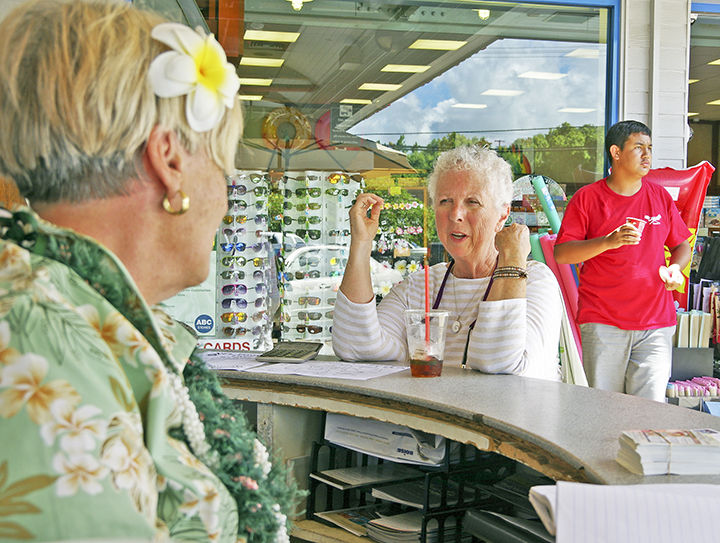LIHUE — Visitor spending on Kauai is up even as local merchants express concerns about higher airline prices making for more thrifty visits while on island. A Hawaii Tourism Authority report on tourism for January through June says the state’s
LIHUE — Visitor spending on Kauai is up even as local merchants express concerns about higher airline prices making for more thrifty visits while on island.
A Hawaii Tourism Authority report on tourism for January through June says the state’s visitor economy is on pace with last year’s record-breaking spending and arrivals.
Statewide, total visitor expenditures for July rose 2.4 percent to $1.4 billion. For the first six months of 2014 visitor spending was up 2.5 percent to $8.7 billion.
“Despite these gains, we are cognizant of changing trends in visitor length of stay and spending,” said HTA President and CEO Mike McCartney. “Visitors are exercising more caution in keeping within their budget threshold as the cost of a Hawaiian vacation increases, competition from alternative destinations grows and the U.S. dollar becomes stronger against foreign currencies.”
On Kauai, visitor expenditures for July were $139.1 million — and a 3.8 percent increase of $161.80 per person, per day spending. The year-to-date spending increased 5.5 percent from $840.4 million last year to $887 million this year— and a 3.7 percent increase to $170.10 in daily spending.
The average length of stay on Kauai for July fell 1.7 percent, from 7.82 to 7.66 days. The year-to-date average stay increased 2.5 percent from 7.67 to 7.87 days.
Lori Barrett, marketing manager for Blue Dolphin Charters in Port Allen, said it has been “a very different year.”
“We are still up but there are a lot more bargain travelers this year,” she said.
Barrett is also the sales director for Best Publishing Kauai, which produces a series of visitor coupon and guide books. She sees a different pattern developing.
Some of her clients are reporting higher numbers overall but business is not as steady or consistent as it tends to be during a busy summer. It will be busy one week and not the next and retail is fighting to break even, she said.
“Most of my clients are telling me that the people are coming here but they are just not spending as much as they were,” Barrett said. “Generally, they are not as busy but retail is suffering more, with some art galleries doing OK and some not.
The cost of tourist operations and their competition makes it difficult to undercut one another, she said. Once a price war begins it could take years to pull the prices back to normal, she added.
Randy Francisco, president and CEO of the Kauai Chamber of Commerce, said tourism should act as Kauai’s primary economic engine. It should be a driver to the other sectors including construction, retail, real estate and even the nonprofit sector.
“A lot of businesses are still trying to recover and this is important to the tourism authority,” Francisco said.
For the month of July, air arrivals from the U.S. West were up 4.5 percent, while U.S. East arrivals were up 3.7 percent. The biggest increase was from San Diego, followed by Portland, Seattle, Denver and Los Angeles, while air arrivals fell from San Jose, Oakland, San Francisco and Phoenix.
“The Hawaiian Airlines Oakland and Los Angeles service was seasonal, so we knew that will be winding down after the summer rush,” said Sue Kanoho, president and CEO of Kauai Visitors Bureau. “The decrease could be a shift in service, for example, dropping from five flights to three. Unfortunately, the airlines don’t always tell us when they add a flight or cut back on a route.”
Canada arrivals were up 14.1 percent, Kanoho said. Japan visitors numbers continued to fall, as did cruise ship visitors by 4.6 percent.
“The Japanese market continues to be somewhat limited in growth,” Kanoho said.
There was a time when tourist helicopters, boats and luau companies would expect visitors to try all three during a visit to the island, Barrett said. Today, visitors are often dining in at their private condo or private rental and are choosing to experience just one air, sea or luau event rather than all three.
“I think everyone is feeling like it will remain the same until airfares go down and that will give people a little more expendable income,” she said. “People are always looking for value and if they are paying $1,500 to fly when the same ticket cost $700 one year ago, and with the hotels pricier now, they are staying in more, hiking and biking and doing the things that don’t cost as much money.”
The reports from the jewelry, arts and souvenir stores are the same, Barrett said. She attributes the thrifty visits to costly travel expenses.
“Airfare has increased 25 percent over five years and that limits the things for people to do while on vacation here,” she said.


